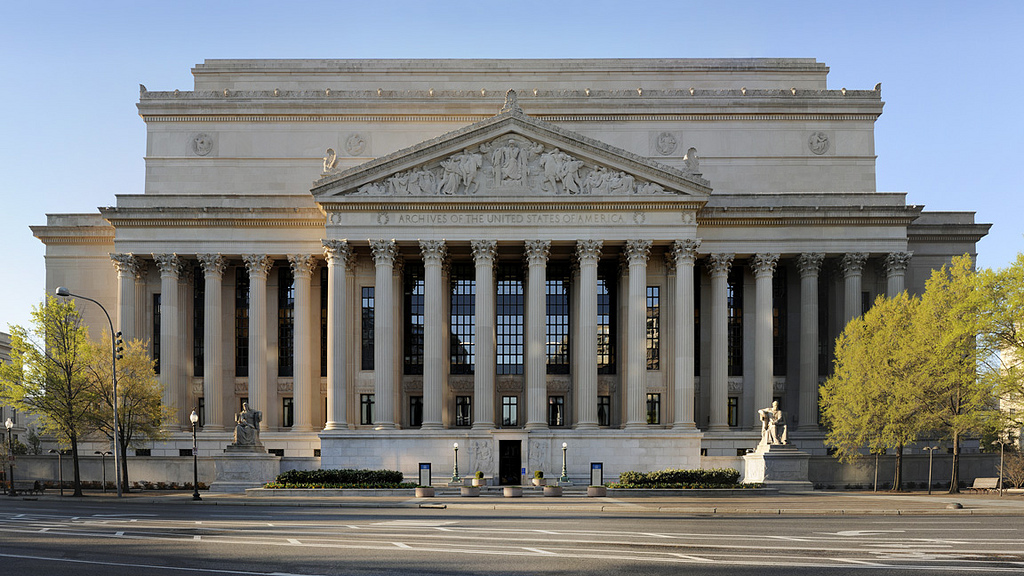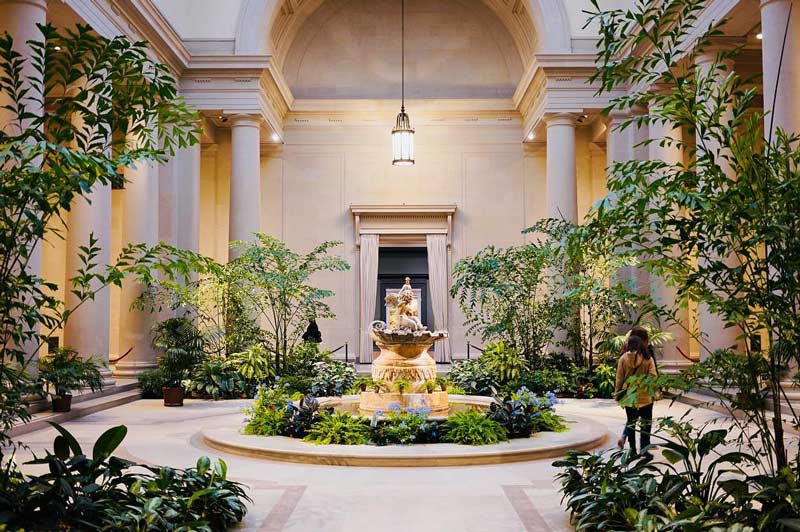Bureau of Printing and Engraving https://washington.org/find-dc-listings/bureau-engraving-printing
Faced with the growing costs of preparing for civil war in 1861, but
limited in its ability to raise the required sums of money, Congress
resorted to the use of paper money and authorized a general circulation
of currency notes for the first time since the failed Continental Currency
of the American Revolution. Such financial difficulties, precipitated by
military and constitutional crises, led to the emergence of the Bureau
of Engraving and Printing. The paper notes were essentially Government IOUs, paid out in lieu of traditional coin payments, and were called Demand Notes because they
were payable “on demand” in coin at certain Treasury facilities. The
U.S. Government had no facility for the production of paper money in
August 1861, so a private firm produced the Demand Notes in sheets
of four notes. These sheets were then sent to the Treasury Department,
where dozens of clerks signed the notes and scores of female workers
cut the sheets and trimmed the notes by hand. A new issue of paper
currency, called United States Notes, replaced the Demand Notes the
following year. While signatures were engraved on the United States
Notes, the work of placing seals on them, as well as trimming and
separating, took place in the Treasury. Later in 1862, Spencer Clark,
chief clerk in the Treasury Department’s Bureau of Construction, used
steam-powered machines to trim and separate some of the notes.
Gradually, additional work on currency and Treasury Securities,
including engraving and printing, devolved to Clark’s operations.
to learn it all go to: BEP History https://www.moneyfactory.gov/images/BEP_History_Sec508_web.pdf
8/15/1974
This time we waited till rush hour was over and then took the free way to DC.
Our first stop was The Bureau of Printing and Engraving Here with arrows and recorded message they direct you thru stamp making, document engraving and finally minting money–Millions of dollars worth just setting around in stacks.
-

Vintage Standard Size China Tea Pot with Removalbe Tea Holder
$21.74
FBI https://www.fbi.gov/contact-us/fbi-headquarters/the-fbi-experience
From its inception in 1908 until 1975, the main offices of the FBI were housed in the Department of Justice building. The first request for a separate FBI building occurred in 1939. Although the Public Buildings Agency initiated plans for an FBI building in 1941, America’s entry into World War II required postponing all government building projects. The next serious request to Congress for a separate building was not made until 1961.
Congress approved a separate FBI building in April 1962. The General Services Administration (GSA), which handles public building construction, allocated $12,265,000 for architectural and engineering design. At that time, the total estimated cost was $60 million. GSA selected Charles F. Murphy and Associates of Chicago, Illinois as architects, and Berswenger, Hoch, Arnold and Associates of Akron, Ohio for engineering. The National Capital Planning Commission approved the site; the building design required approval from the National Capital Planning Commission, GSA, the Commission on Fine Arts, and the Pennsylvania Avenue Advisory Council. Although all conferences between GSA and the architects were open to Bureau representatives and GSA sought FBI opinion, neither the FBI nor the Department of Justice had to approve the exterior design. The Bureau, however, allocated the interior space.
On January 2, 1963, GSA announced the approval of the site for the FBI building bounded by Pennsylvania Avenue and E Street and Ninth and Tenth Streets, Northwest. GSA purchased the land at a of cost $41.17 per square foot. The original design prepared in 1963 by Charles F. Murphy and Associates was a traditional box-like structure. It incorporated the Bureau’s request for a central core of files surrounded by offices.
The Pennsylvania Avenue Advisory Council revealed its grand design for Pennsylvania Avenue in April 1964. The Council envisioned a rejuvenated Pennsylvania Avenue, its north side lined with shops and buildings with open arcades and courtyards. Because major parades marched down the avenue, all new buildings would have open second floors to accommodate spectators. The FBI building would be the first government structure to be built on the avenue’s north side. Therefore, the Pennsylvania Avenue Advisory Council urged GSA to redesign the building to conform to the plan. GSA agreed.
https://www.fbi.gov/history/history-of-fbi-headquarters
We left the car and caught a taxi to the FBI–where we stood in line for an hour and a half buying drinks and post cards from the mushroom like vendors that grew along the curbs.
The tour itself, led by an FBI agent took an hour and gave you a chance to view labs, exhibit areas and a demonstration at the gun range.
-

Special Report Death of a Beatle From 12/22/1980 Newsweek Coverage on Murder of John Lennon
$10.00
National Archives https://museum.archives.gov/
Congress established the National Archives in 1934 to preserve and care for the records of the U.S. Government. Previously, Federal records were kept in various basements, attics, abandoned buildings, and other storage places with little security or concern for storage conditions. In 1935, Archives staff and WPA workers began to survey Federal records and the next year the first batch of federal records were transferred to the new National Archives building in Washington, DC. From one building on Pennsylvania Avenue, the National Archives now has over 40 facilities nationwide including field archives, Federal Records Centers, Presidential Libraries, the Federal Register, and the National Historical Publications and Records Commission.
The National Archives has been compiling photographs of staff at work, records storage conditions, building construction, personnel activities, and much more since our establishment in 1934. Visit our Flickr galleries to see a selection National Archives photographs. And visit our Online Catalog to see thousands more of our historic photographs.
https://www.archives.gov/about/history
From there we walked to the National Archives where we viewed famous documents–including The Constitution, Declaration of Independence and the Bill of Rights. These documents are quite badly faded from poor care in the past and now are preserved in glass vaults which go several hundred feet into the ground every night. Civilization might perish but not our precious documents. But if someone survives don’t you think it would be useful if they can find them under the rubble?
-

Porter Wagoner Show 1960s Booklet
$20.00
The National Gallery https://www.nga.gov/visit.html
The National Gallery of Art was conceived and given to the people of the United States by Andrew W. Mellon (1855–1937). Mellon was a financier and art collector from Pittsburgh who came to Washington in 1921 to serve as secretary of the treasury. During his years of public service he came to believe that the United States should have a national art museum equal to those of other great nations.
In 1936 Mellon wrote to President Franklin D. Roosevelt offering to donate his superb art collection for a new museum and to use his own funds to construct a building for its use. With the president’s support, Congress accepted Mellon’s gift, which included a sizable endowment, and established the National Gallery of Art in March 1937. Construction began that year at a site on the National Mall along Constitution Avenue between Fourth and Seventh Street NW, near the foot of Capitol Hill.
Next another short walk to the National Gallery, here we viewed Monets, Rembrants, Degas, and Holbiens in large, spacious and well lit rooms. A domed marble building with fountains and gardens and even a special exhibit on African Art and Motion. This was very enjoyable–tho their main emphasis was on French artists. They do have the only Lenonardo De Vinci in the Western Hemisphere. We had super here and caught a taxi back to our car.
-

Rusty Wallace Full Moon Poster with His #2 Car Poster by Sam Bass With Artists Actual Autograph On bottom of Print
$64.00′https://www.etsy.com/listing/633159843/rusty-wallace-full-moon-poster-with-his?ref=shop_home_active_80
Jefferson Monument https://washington.org/dc-guide-to/jefferson-memorial
The Memorial
Dedicated by President Franklin Delano Roosevelt on April 13, 1943, the Thomas Jefferson Memorial stands in a straight line with the White House. Architect John Russell Pope, influenced by Jefferson’s taste in classical architecture, echoed the style seen in Jefferson’s two most famous buildings – Monticello and the University of Virginia Rotunda.
The Man
Founding Father… Revolutionary… Renaissance Man. Thomas Jefferson was the primary author of the Declaration of Independence, first Secretary of State for the United States of America, and a complex, 19th-century man with a wide ranging impact on the very makeup of America itself https://www.nps.gov/thje/learn/historyculture/index.htm
-

COCKTAIL MARTINI SHAKER Rare Japanese Gold Rooster Art Deco Design Entire set
$159.97





